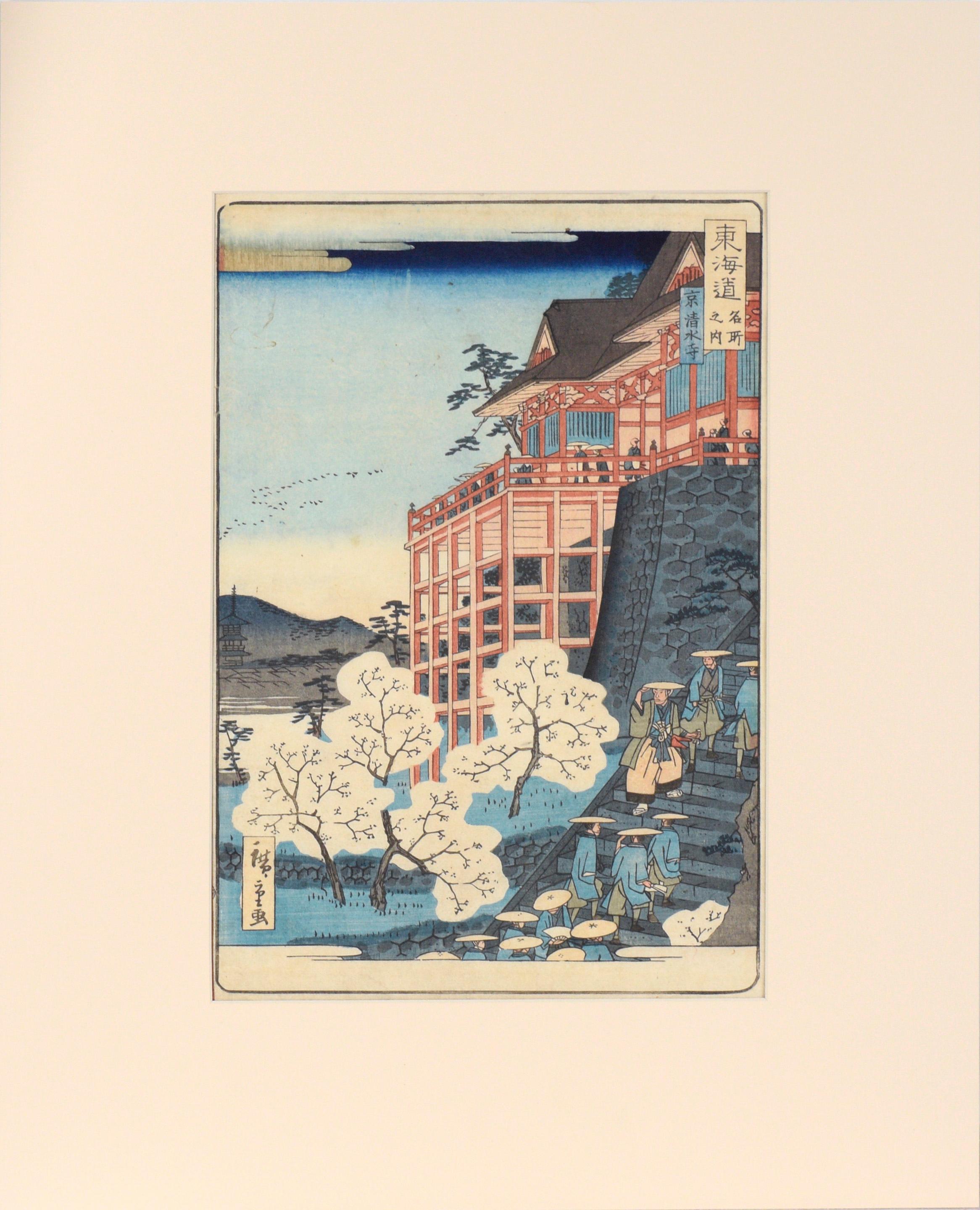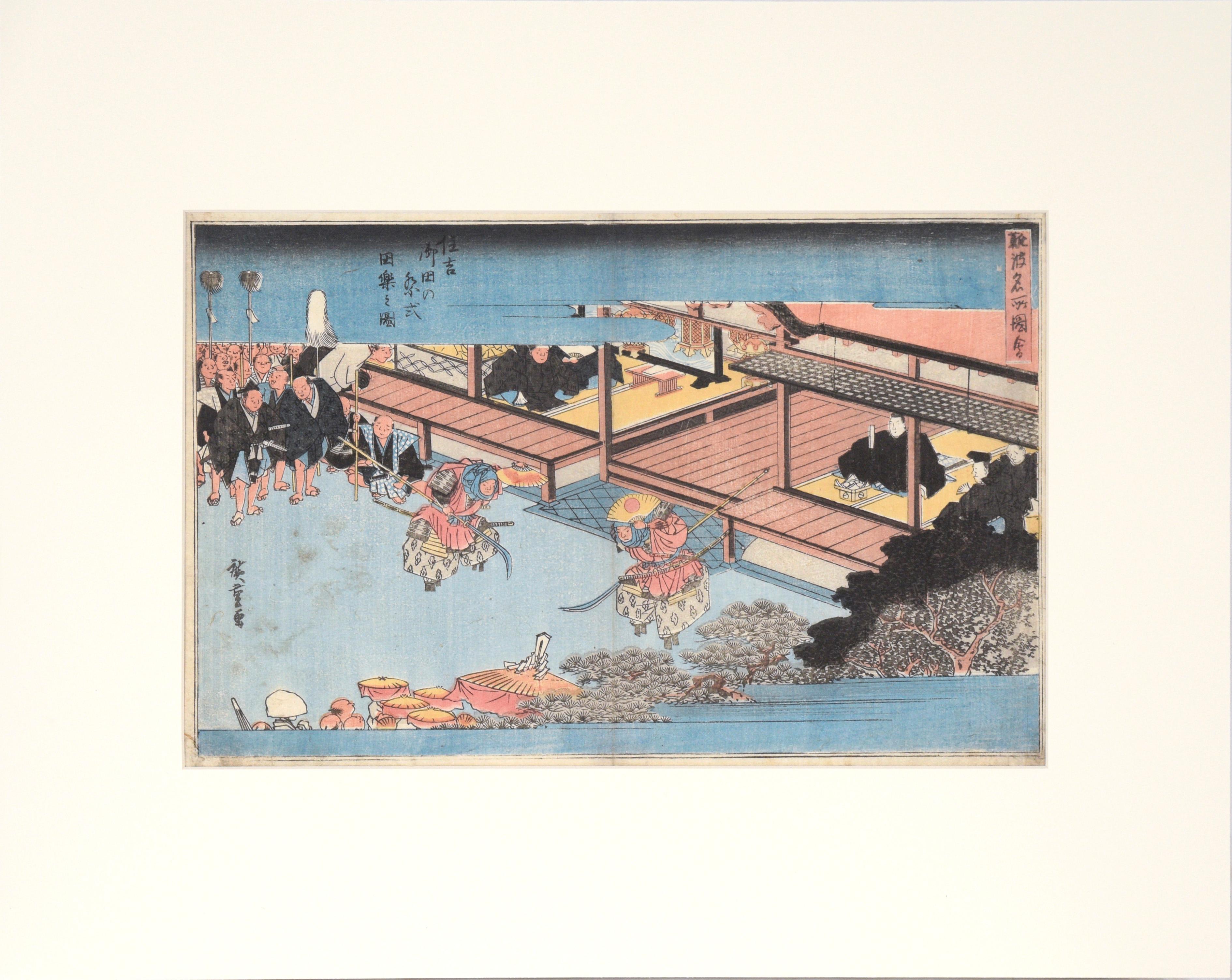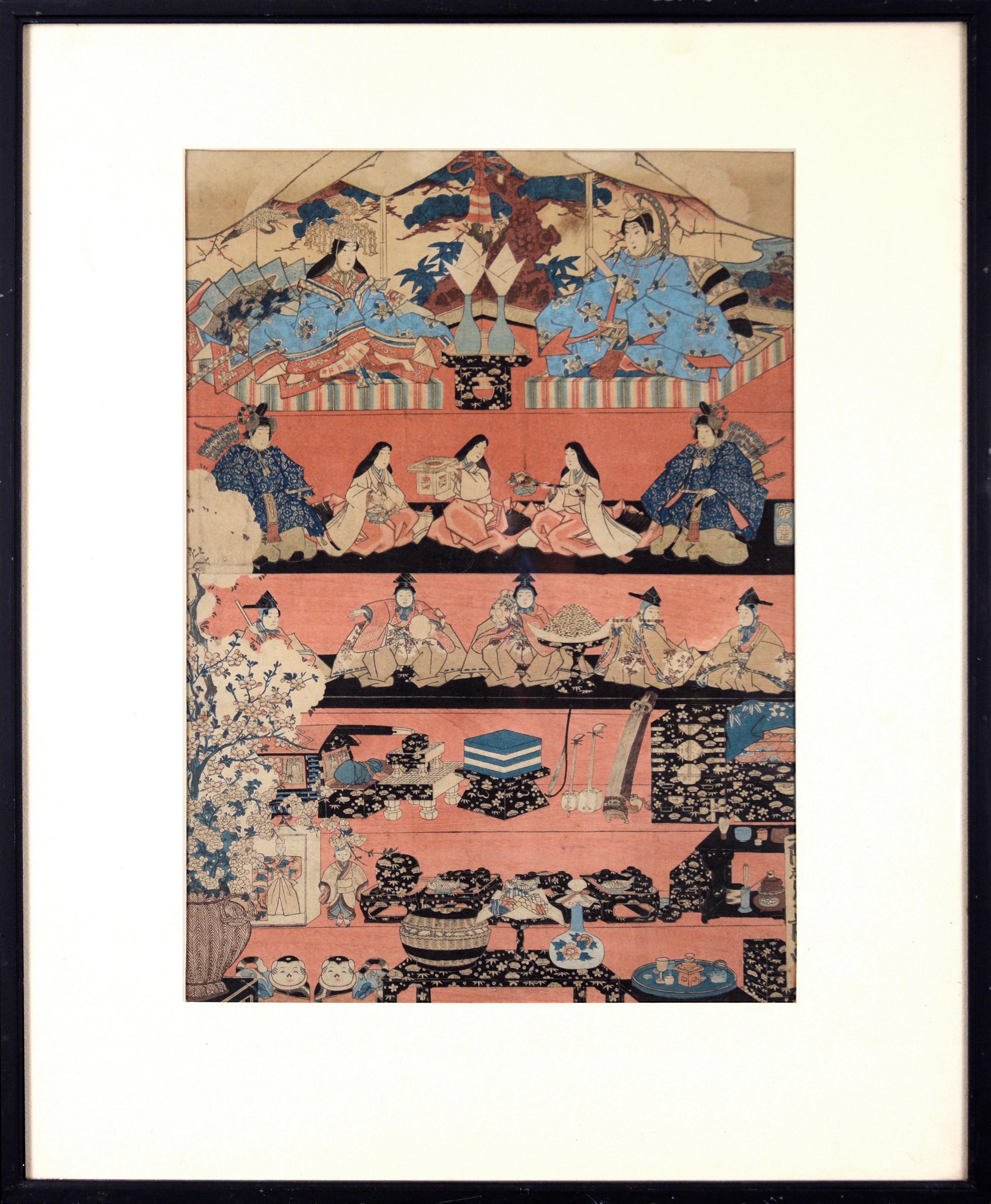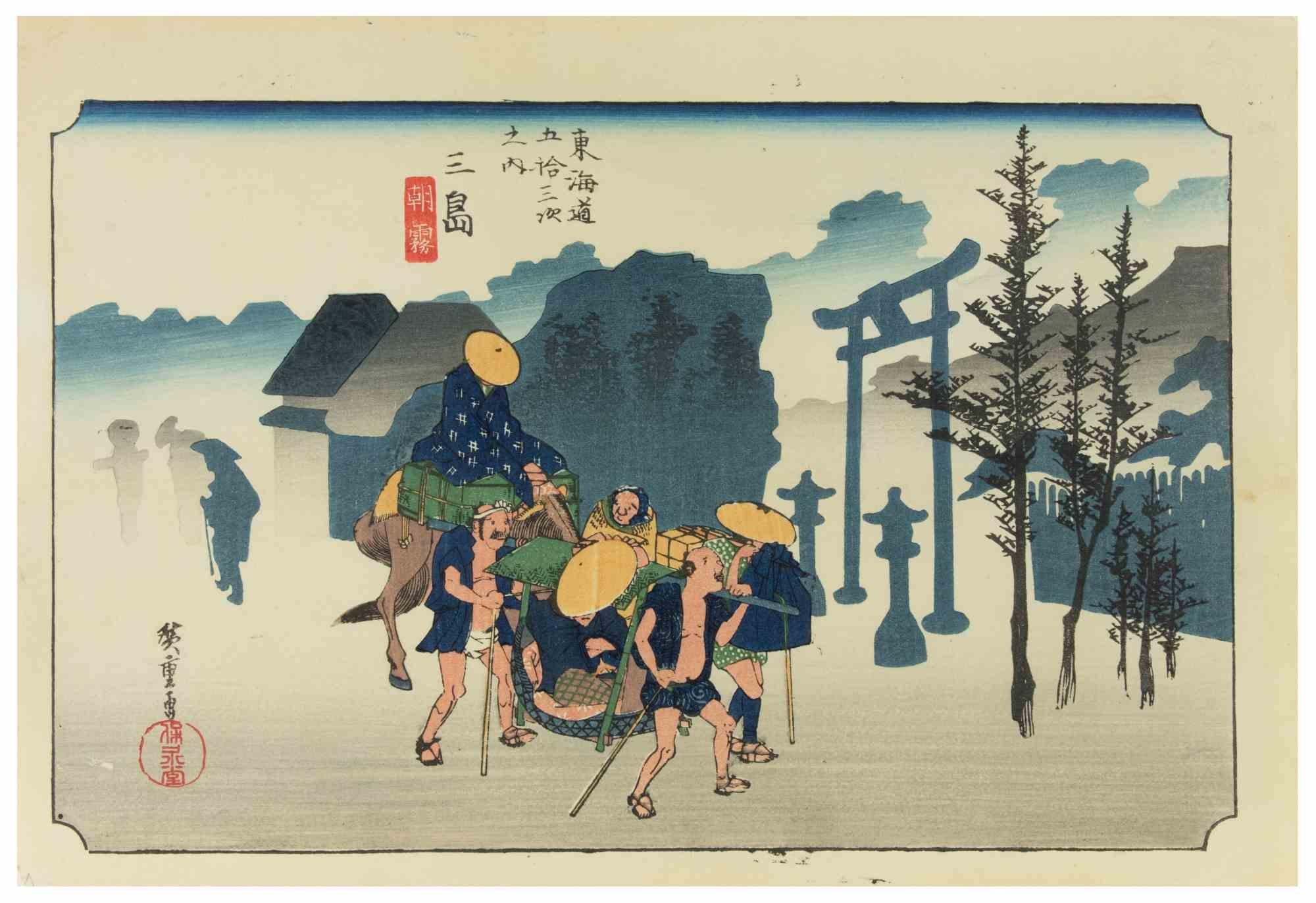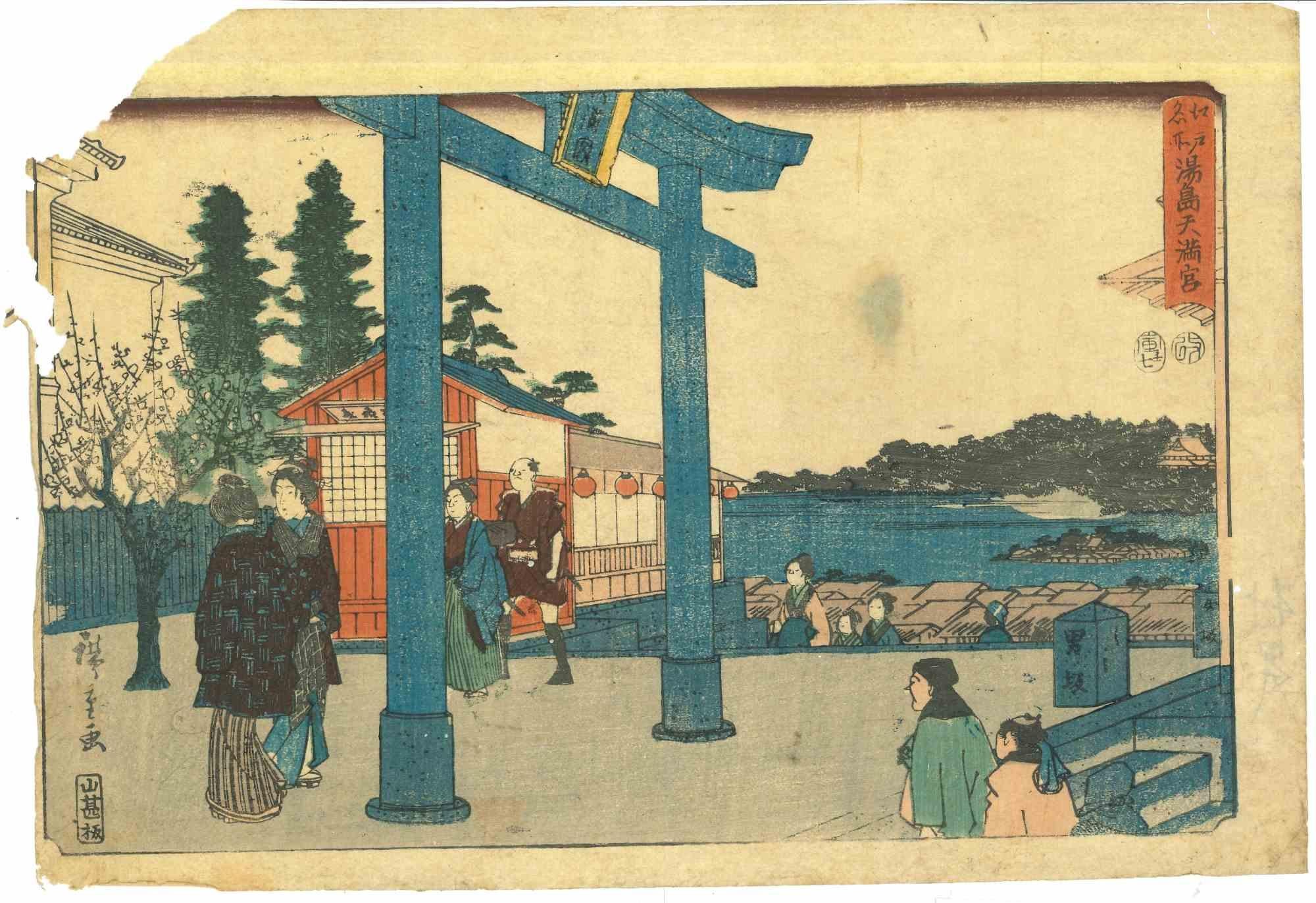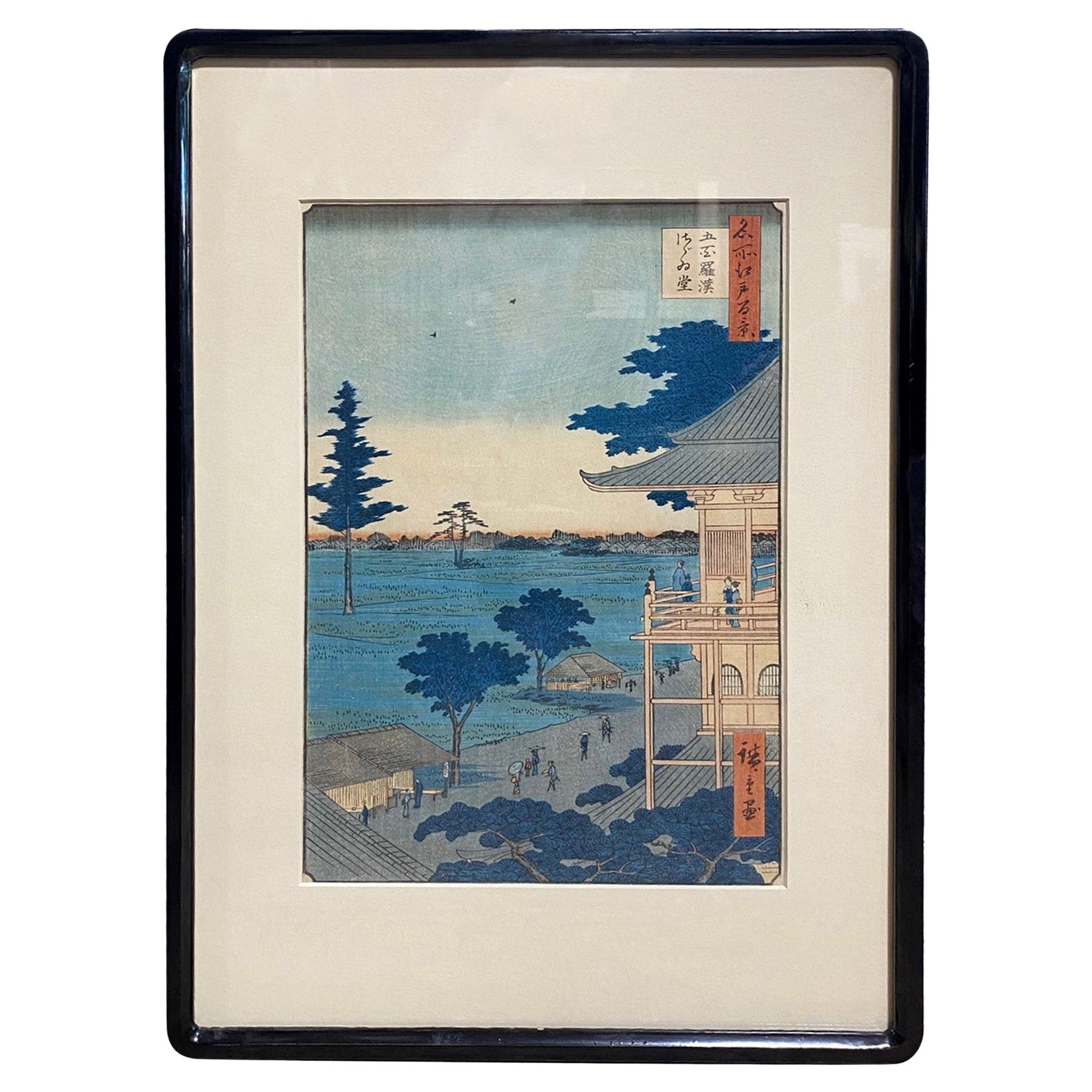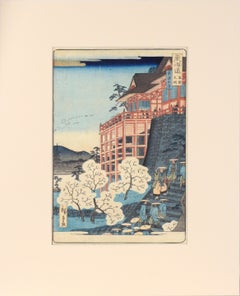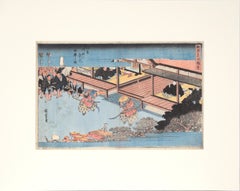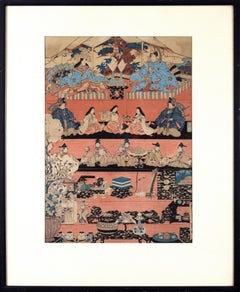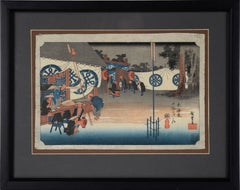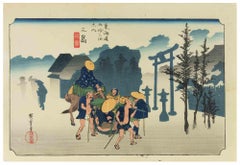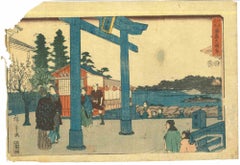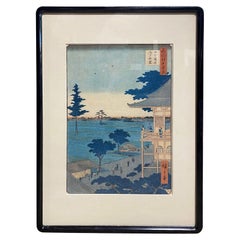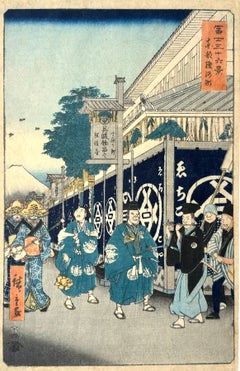Items Similar to "The Kaminarimon at the Kanseon Temple in Asakusa" - Original Japanese Print
Want more images or videos?
Request additional images or videos from the seller
1 of 11
Utagawa Kunitsuna"The Kaminarimon at the Kanseon Temple in Asakusa" - Original Japanese Print1853
1853
$850
£652.76
€748.06
CA$1,196.59
A$1,340.45
CHF 698.49
MX$16,350.67
NOK 8,876.26
SEK 8,369.68
DKK 5,583.31
About the Item
"The Kaminarimon at the Kanseon Temple in Asakusa" - Original Japanese Print
Japanese Print "The Kaminarimon at the Kanseon Temple in Asakusa", from the series "Famous Places in Edo" by Utagawa Kunitsuna (Japanese, 1786-1865).
Signed and dated "Kunitsuna" on bottom of paper.
Mat: 14"H x 18"W
Paper: 12 3/4"H x 16 1/4"W
Image: 9 3/4"H x 14"W
Utagawa Kunisada I (歌川國貞 [初代] 1786-1865) was the most celebrated actor-print designer of the nineteenth century, and certainly the most prolific. He was born and raised in the Honjô district of Edo, the son of a well-to-do ferry owner. This licensed ferry service provided the family with a measure of financial security that Kunisada was able to access during his early years of printmaking apprenticeship. His family name was Tsunoda (角田) and given name Shôgorô IX (庄五朗) and also Shôzô (庄蔵). [Note: Some have read the kanji for Tsunoda 角田 as "Sumida."]
In 1800-1801, at the age of fourteen or fifteen, he became a pupil of Utagawa Toyokuni I (歌川豊國 1769-1825) and took the artist name "Kunisada" (國貞) soon thereafter (see signature image at immediate right). In 1/1807 he produced his first independent work — an illustrated promotional brochure for perfumed oil made by Yorozuya Shirobei. The text was wirtten by the eminent novelist Takizawa Bakin (滝沢馬琴 1767-1848) and titled "Gate of immortality, New Year's water for cosmetics (Oi senu kado keshô no wakamizu). Distributed as a New Year's gift, it was not a commercial production, although it was later sold as such in a trade edition in 1809.
In 3/1807, Kunisada provided designs in the genre of bijinga (pictures of beautiful women: 美人画) for the series Keisei junitoki (Twelve hours of the courtesans: 傾城十二時). These early bijinga were somewhat immature and suffered in comparison to his designs in this genre even just two years later in 1809. Kunisada's first theatrical print was made in 3/1808, a fan print (uchiwa-e: 團扇絵) portraying Matsumoto Kôshirô V as Nikki Danjo, published by Senzaburô (Dansendô). The following month, Kunisada depicted the Osaka-based actor Nakamura Utaemon III performing at the Nakamura-za in Edo as Yojirô the monkey trainer in the play Oshun Denbei. Soon after, he completed a triptych of beauties and then embarked on illustrations for books (ehon or picture books: 絵本). He would continue to design for ehon throughout his career, providing huge numbers of images for actor-print books and illustrated popular fiction. Even early on, he was prodigiously creative in this genre, as in 1808 when he contributed to no fewer then fourteen ehon.
By the 1810s Kunisada was involved in designing more than fifty series of beauties and actors, as well as a few warrior prints. Yet although much of his reputation rests upon his actor prints (yakusha-e: 役者絵), which represent roughly sixty percent of his total oeuvre, Kunisada was in fact a leading designer of bijinga. He also excelled in the design of surimono (privately issued and distributed high-quality specialty prints: 摺物). He produced large numbers of surimono in the prevailing shikishiban format (色紙判 approx. 205 x 185 mm), such as the one shown below from 11/1823 depicting Ichikawa Danjûrô VII as Iga no Jutarô.
It was during the second decade of the nineteenth century that Kunisada established his teaching studio. By 1814 his students were already designing their own book illustrations for publication. It has been estimated that as many as 15,000 to 20,000 print designs were issued from his studio, as well as thousands of illustrations for woodblock-printed books (ehon). Given that some of these single-sheet prints and ehon were issued in thousands of impressions, the number of actual printed sheets sold by the various publishers over Kunisada's long career must have been astounding. Little wonder that his prints are among the most frequently encountered in collections around the world. Kunisada enjoyed enormous commercial success once he established his studio, whose production of Utagawa-school woodcuts dominated the world of ukiyo-e prints from the 1820s into the beginning of the Meiji era. It seems that without question, he became the most prolific and most commercially successful artist in the history of the ukiyo-e school.
- Creator:Utagawa Kunitsuna (Japanese)
- Creation Year:1853
- Dimensions:Height: 14 in (35.56 cm)Width: 18 in (45.72 cm)Depth: 1 in (2.54 cm)
- Medium:
- Movement & Style:
- Period:
- Condition:Very good condition. Mat is new.
- Gallery Location:Soquel, CA
- Reference Number:Seller: N96771stDibs: LU54215542552
About the Seller
5.0
Platinum Seller
Premium sellers with a 4.7+ rating and 24-hour response times
Established in 1986
1stDibs seller since 2014
2,965 sales on 1stDibs
Typical response time: <1 hour
- ShippingRetrieving quote...Shipping from: Soquel, CA
- Return Policy
Authenticity Guarantee
In the unlikely event there’s an issue with an item’s authenticity, contact us within 1 year for a full refund. DetailsMoney-Back Guarantee
If your item is not as described, is damaged in transit, or does not arrive, contact us within 7 days for a full refund. Details24-Hour Cancellation
You have a 24-hour grace period in which to reconsider your purchase, with no questions asked.Vetted Professional Sellers
Our world-class sellers must adhere to strict standards for service and quality, maintaining the integrity of our listings.Price-Match Guarantee
If you find that a seller listed the same item for a lower price elsewhere, we’ll match it.Trusted Global Delivery
Our best-in-class carrier network provides specialized shipping options worldwide, including custom delivery.More From This Seller
View AllKiyomizu Temple, Scenes of Famous Places along Tôkaidô Road - Woodblock on Paper
By Utagawa Hiroshige II
Located in Soquel, CA
Kiyomizu Temple, Scenes of Famous Places along Tôkaidô Road - Woodblock on Paper
Full Title:
Kyoto: Kiyomizu Temple (Kyô Kiyomizudera), from the series Scenes of Famous Places along...
Category
1860s Edo Landscape Prints
Materials
Ink, Rice Paper, Woodcut
Sumiyoshi: Dengaku dance performed during an Onda ceremony - Woodblock Print
By Utagawa Hiroshige
Located in Soquel, CA
Sumiyoshi: Dengaku dance performed during an Onda ceremony - Woodblock Print
Bright woodblock print by Utagawa Hiroshige (Japanese, 1797-1858). In this scene, two dancers with swords and fans are facing each other, in the center of a courtyard. There are spectators surrounding them, including nobles in black clothing on a balcony.
Presented in a new off-white mat with foamcore backing.
Mat size: 16"H x 20"W
Paper size: 9.63"H x 14.5W"
Utagawa Hiroshige (1797-1858, sometimes called Ando Hiroshige) was the second of the two great masters of the Japanese landscape woodblock print...
Category
1830s Edo Figurative Prints
Materials
Ink, Rice Paper, Woodcut
"Various Himochi" Wagashi Festival Japanese Woodblock Print by Utagawa Toyokuni
By Utagawa Toyokuni
Located in Soquel, CA
"Various Himochi" Wagashi Festival Japanese Woodblock Print by Utagawa Toyokuni
Rare oversized early 19th century 5-tiered woodblock by Utagawa Ichiyosai Toyokuni, (Japan, 1769-1825), a Japanese lord and wife oversee a sekku festival of food, music, and dolls or toys. '"oshi" is the first day of “Mi (Snake)” in the third month of the lunar calendar. This day, known in modern Japan as the Girls' Festival, originated in China as a form of purification ceremony in which water and drinking peach blossom wine were used to drive away evil. Many kinds of hishi-mochi appear in this picture of hina ningyo (dolls associated with Hinamatsuri, or the Girl’s Day) from Omochae.
The custom of eating special dishes at events throughout the year and at milestones in people's lives has existed since ancient times. This paragraph specifically focuses on the annual event called sekku, and life events that involve eating sweets. Joshi is the first day of “Mi (Snake)” in the third month of the lunar calendar. This day, known in modern Japan as the Girls' Festival, originated in China as a form of purification ceremony in which water and drinking peach blossom wine were used to drive away evil. According to the Keiso saijiki, in ancient China, on the third day of the third lunar month, people ate “ryuzetsuhan,” which is the juice of gogyo (Jersey cudweed) mixed with rice flour and nectar. In Japan, there is a record in the Heian period history book Nihon Montoku tenno jitsuroku [839-5] that it was an annual event to make kusamochi using gogyo on the third day of the third month of the lunar calendar, which may have been influenced by Chinese customs.
The tradition of eating kusamochi on the third day of the third month of the lunar calendar continued after that. By the Edo period, however, hishimochi had come to be used as a sweet to serve on the third day of the third month. A picture of a hishimochi is included in the Morisada manko , which we mentioned in Part 1. According to it, hishimochi in the Edo period were often three layers of green-white-green instead of the now common red-white-green. However, it is possible to see from our collection that not all hishimochi were made in this way. Omochae published in 1857, is a good example. Omochae is a type of ukiyoe print...
Category
1820s Edo Figurative Prints
Materials
Ink, Rice Paper, Woodcut
Stage 48 of the 53 Stages of the Tokaido - Japanese Woodblock on Rice Paper
By Utagawa Hiroshige
Located in Soquel, CA
Stage 48 of the 53 Stages of the Tokaido - Japanese Woodblock on Rice Paper
Woodblock print of clothing vendors by Utagawa Hiroshige (Japanese, 1797-1858). Originally printed in 183...
Category
1830s Impressionist Figurative Prints
Materials
Rice Paper, Woodcut
Mitate of a Daimyo's Procession Crossing Ryogoku Bridge - Woodblock Print
By Keisai Eisen
Located in Soquel, CA
Mitate of a Daimyo's Procession Crossing Ryogoku Bridge - Woodblock Print
Woodblock print of a procession by Keisai Eisen (Japanese, 1790–1848). Terrific triptych of a procession of...
Category
Early 19th Century Edo Figurative Prints
Materials
Ink, Rice Paper, Woodcut
No. 45, View of Akasaka from "Comical Views of Famous Places in Edo" Woodblock
Located in Soquel, CA
No. 45, View of Akasaka from "Comical Views of Famous Places in Edo" Woodblock
Whimsical woodblock print by Utagawa Hirokage (Japanese, active 1855–1865). Four people are sitting on...
Category
1860s Edo Figurative Prints
Materials
Rice Paper, Woodcut
You May Also Like
Asagiri - Woodcut by Utagawa Hiroshige - 1832
By Utagawa Hiroshige
Located in Roma, IT
Asagiri is a woodcut print realized by Utagawa Hiroshige in 1832.
It is part of the suite "The Fifty-three Stations of Tokaido".
Very good condition.
Category
1830s Modern Figurative Prints
Materials
Woodcut
Japanese Woodcut Print - Original Woodcut Print by Utagawa Hiroshige - 19th Cent
By Utagawa Hiroshige
Located in Roma, IT
This is a superb polychrome woodblock print (nishiki-e, ink and color on paper), likely realized by Utagawa Hiroshige (Japanese, 1797-1858) at the middle of 19th century. This plate ...
Category
19th Century Modern Figurative Prints
Materials
Woodcut
Utagawa Ando Hiroshige Japanese Print Sazaidō Hall at Five Hundred Rakan Temple
By Utagawa Hiroshige (Ando Hiroshige)
Located in Studio City, CA
A wonderful Japanese woodblock print by famed Japanese artist Utagawa Hiroshige (Ando Hiroshige) (1797-1858) titled "The Sazaido Hall at the Five Hundre...
Category
Antique Mid-19th Century Japanese Edo Prints
Materials
Paper
Hiroshige Utagawa, The Suruga District in Edo
By Utagawa Hiroshige
Located in Torino, IT
HIROSHIGE UTAGAWA I, Edo 1797 - 1858
The Suruga District in Edo (Tôto Suruga-chô), from the series Thirty-six Views of Mount Fuji (Fuji sanjûrokkei)
Nishiki-e. Color woodcut, signed...
Category
1850s Edo Landscape Prints
Materials
Woodcut
Utagawa Ando Hiroshige Japanese Woodblock Print Kinryuzan Temple, Asakusa
By Utagawa Hiroshige (Ando Hiroshige)
Located in Studio City, CA
A wonderful Japanese woodblock print by famed Japanese artist Utagawa Hiroshige (Ando Hiroshige) (1797-1858) titled "Kinryuzan Temple, Asakusa" was initially conceived in 1856. It i...
Category
20th Century Japanese Edo Prints
Materials
Paper
Utagawa Hiroshige 歌川廣重 Woodblock from"The 53 Stations of the Tokaido" 1832
Located in Norton, MA
Utagawa Hiroshige 歌川廣重 Woodblock from"The 53 Stations of the Tokaido" 1832
Artist:
Hiroshige Utagawa was born in Edo as Tokutaro Ando and grew up in a minor samurai family. His father belonged to the firefighting force assigned to Edo Castle. It is here that Hiroshige was given his first exposure to art: legend has it that a fellow fireman tutored him in the Kano School of Painting, though Hiroshige’s first official teacher was Rinsai. Though Hiroshige tried to join Toyokuni Utagawa's studio, he was turned away. In 1811, young Hiroshige entered an apprenticeship with the celebrated Toyohiro Utagawa. After only a year, he was bestowed with the artist name Hiroshige. He soon gave up his role in the fire department to focus entirely on painting and print design. During this time he studied painting, intrigued by the Shijo school. Hiroshige’s artistic genius went largely unnoticed until 1832.
In Hiroshige's groundbreaking series of woodblock prints, The 53 Stations of the Tokaido (1832-1833), he captured the journey along the Tokaido road, the highway connecting Edo to Kyoto, the imperial capital. With the Tokugawa Shogunate relaxing centuries of age-old restrictions on travel, urban populations embraced travel art and Hiroshige Utagawa became one of the most prominent and successful ukiyo-e artists. He also produced kacho-e (bird-and-flower pictures) to enormous success. In 1858, at the age of 61, he passed away as a result of the Edo cholera epidemic.
Utagawa Hiroshige’s woodblock prints...
Category
Antique Early 19th Century Japanese Prints
Materials
Paper
More Ways To Browse
Japanese Temple
Antique Water Picture
Large Japanese Fan
Japanese Monkey
Monkey Japan
Antique Rice Measure
Meiji Books
Kunisada Triptych
Bust Of Greek Warrior
Calder Lithograph Black And White
Cartier Salvador Dali
Cindy Sherman Poster
Colette Dress
Copper Judaica
David Hockney On Sale
Faith Ringgold
Francisco Toledo Etching
Jim Dine Hearts Lithograph
